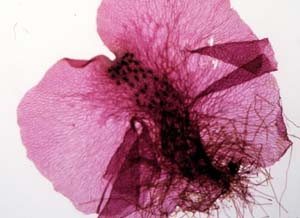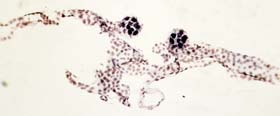|
The sexual organs, the antheridia (carrying the male sex cells) and the archegonia (carrying the female sex cells) are found on the prothallus. The antheridia are found amongst the rhizoids at the base of the plant; the archegonia are situated near the apex. (Move the mouse over the picture for labels) |
 |
|||
|
In wet or damp conditions, sperm cells are released from the antheridia and they swim in a film of water towards the archegonia, apparently attracted towards them by malic acid. Once fertilisation has taken place, successive divisions of the fertilised ovule results in the embryo sporophyte comprising stem, root and leaf. It is this embryo which grows to become the fern plant we are familiar with. Initially the embryo sporophyte gains nourishment from the prothallus, however once the leaf begins photosynthesising, the prothallus gradually withers away and the fern sporophyte grows independently. The life cycle is now complete, an alternation of generations has taken place. The asexual phase, spore production, by the plant we recognise as a fern (the sporophyte), followed by the sexual phase which takes place in a form which we may never even have noticed, the prothallus or gametophyte.
|
||||
Comments to the author Anne Bruce welcomed.
(all images © Anne Bruce)
